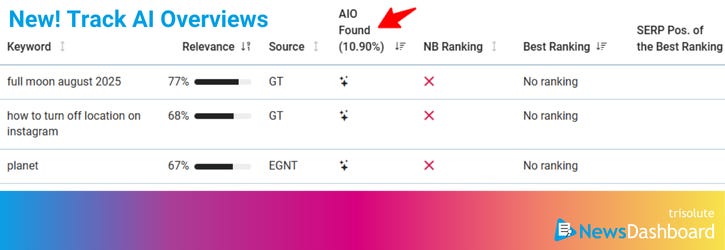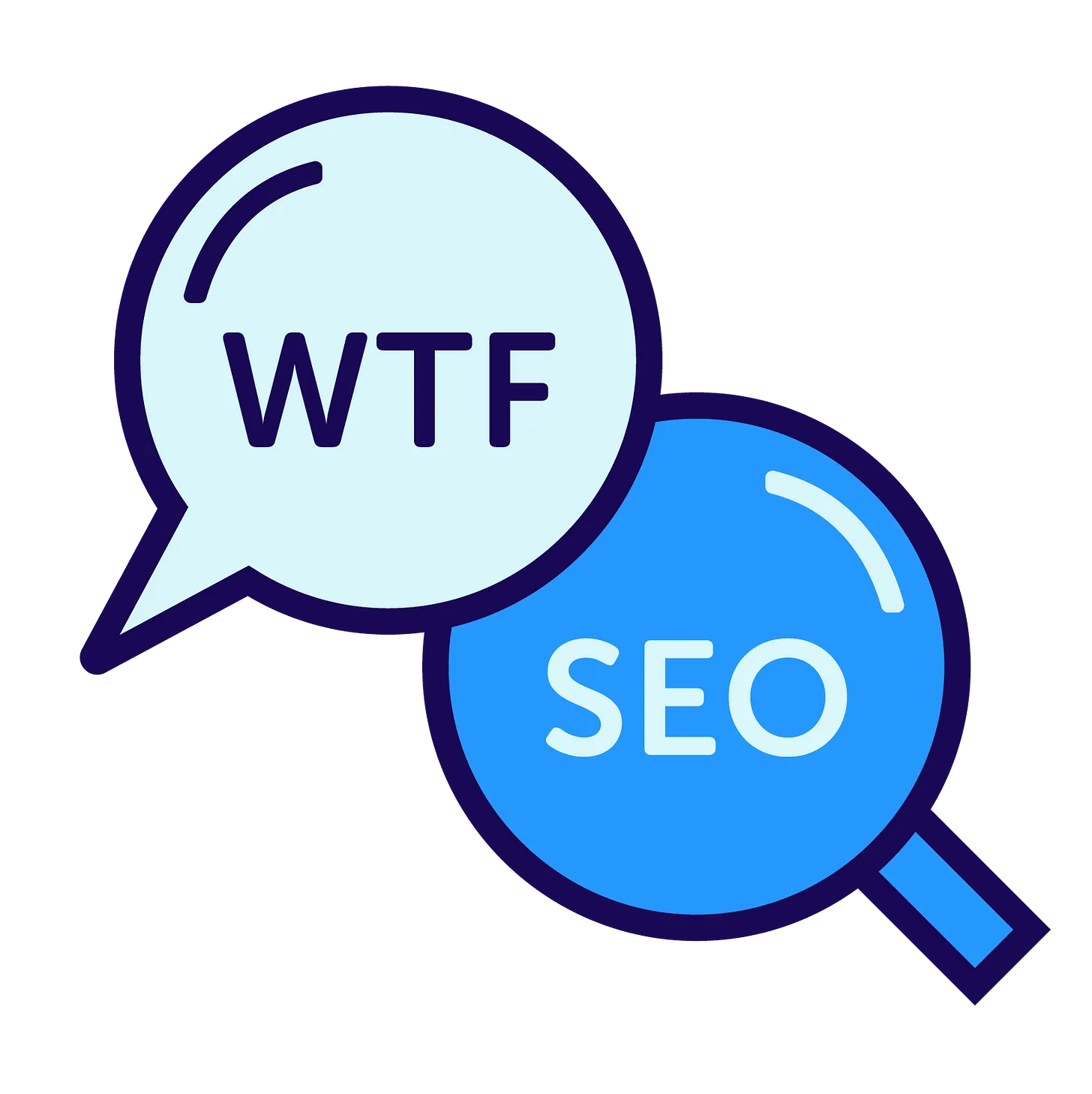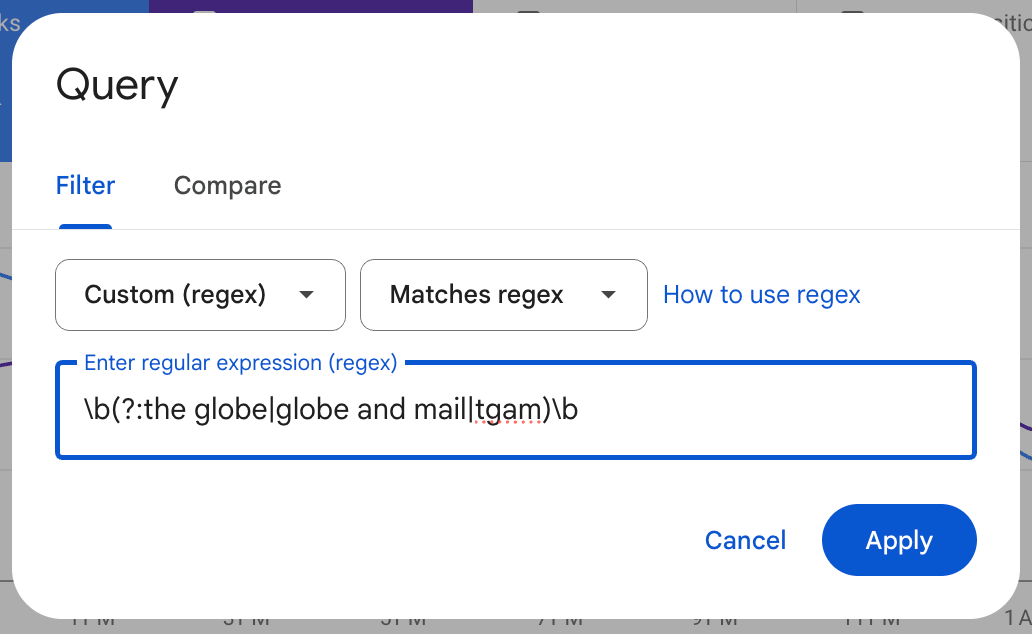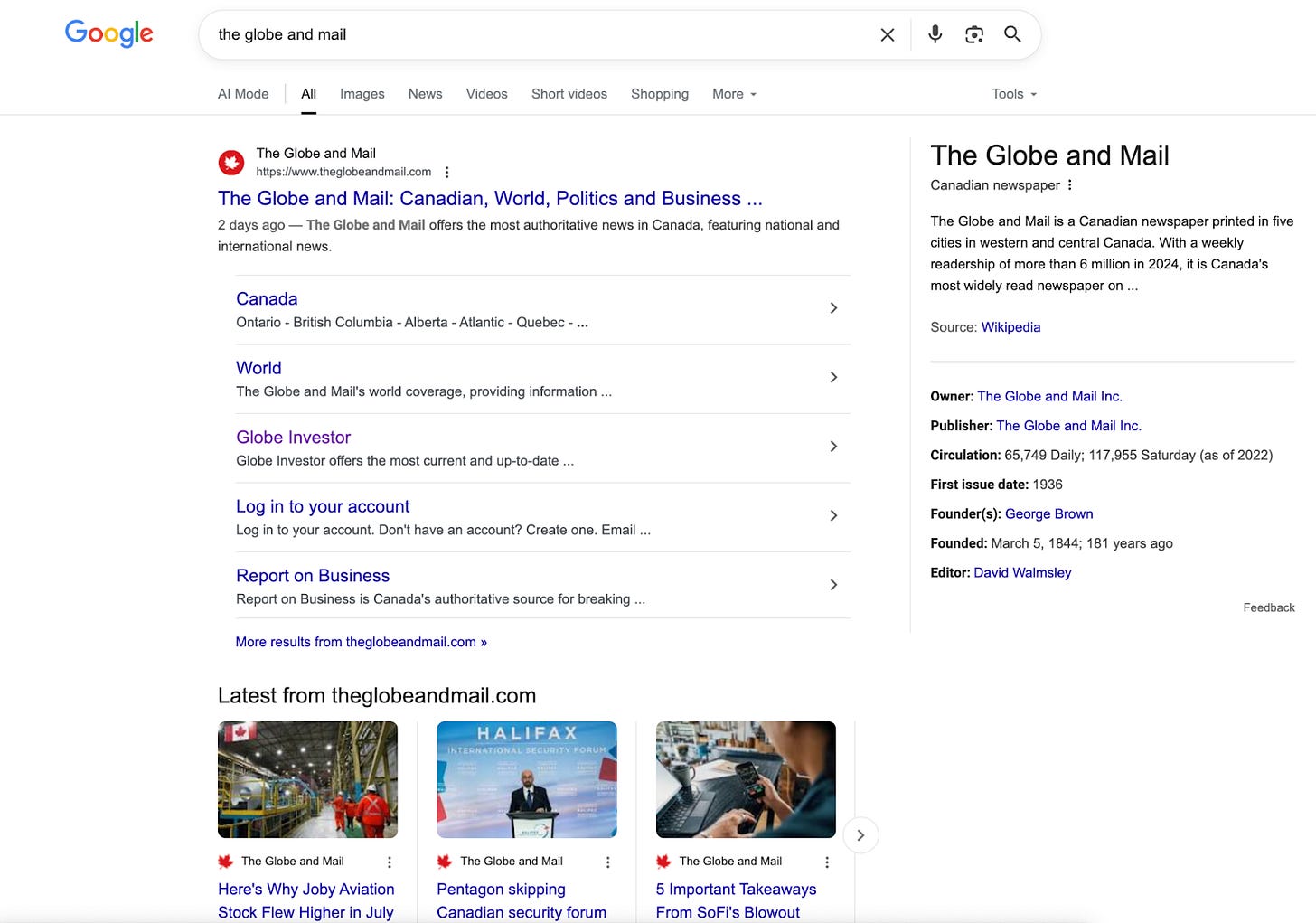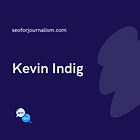Branded search: How to improve your site’s visibility
Learn how to establish a baseline branded search metric and improve your publication’s profile in the age of AI
#SPONSORED
New feature! AI Overview data in the Trisolute News Dashboard
You asked, we delivered. Analyze which keywords are triggering AI Overviews in our near real-time Action View report.
Top features:
See the current AIO percentage.
Filter by keyword category for targeted analysis.
Add your own keywords for a custom report.
Download results with the new Export button.
Hello, and welcome back. Jessie here, back in Toronto after a quick New York City visit to the Guardian office — a trip that included a Jesse Eisenberg spotting, several great bookstores and maybe, almost coming home the proud (read: accidental) owner of a CitiBike. NYC: It’s not Toronto, but it’s still pretty good.
This week: How to effectively do branded search! In a previous newsletter about branded search, we explained the importance of queries that are related to people looking up an organization by name or associated products. In this issue, we cover how to actually improve branded search for your outlet.
Join our community of news SEOs on Slack to chat any time.

Let’s get it.
In this issue:
What is branded search and why it matters
Tips for improving branded search
THE 101
What is branded search and why it matters
Branded search refers to the queries readers use to look up your publication, either by name or by product. These terms are often navigational intent, typically to your homepage, specific tag or topic URLs or author bios.
Analyzing branded search for your site offers valuable insights. These terms reflect how readers perceive your brand, what topics they associate with it and which aspects of your coverage they value most.
Further, branded search matters because:
It is a measure of audience loyalty. A consistent (and ideally slowly increasing) percentage of branded search traffic reflects a devoted readership. Branded terms reveal the topics most closely associated with your publication. For example, “nyt ukraine war” demonstrates an affinity for international coverage for the New York Times.
It is a buffer against Google volatility. With a potential “traffic apocalypse” caused by the adoption of artificial intelligence tools like ChatGPT and AI Mode, brand awareness is key. Branded and direct traffic are cousins: they both reflect active interest. These audiences are more likely to pay for a subscription, share a story or advocate for your coverage.
It could help increase visibility in LLMs. Kevin Indig believes that “the popularity of a brand broadly decides how visible it is in AI Chatbots.” Kevin refers to the concept of brand authority, the “cumulative trust, prominence and perceived expertise a domain earns.” Branded search (specifically, branded search demand) is a part of this.
It sees much higher click-through rates than non-branded terms. The per cent of people clicking to your site from a branded term (i.e., “the globe and mail”) should be higher than via general news query (i.e., “interest rate decision today”).
A strong branded search profile is all upside. Brands are mentioned and cited often in AI tools like AI Mode, making a strong profile even more useful. A focus on branded search can help strengthen audience engagement and overall identity, potentially driving more traffic to your site.
🔗 Read more: Branded search for news SEO
THE HOW TO
How to improve your branded search
Establish your baseline
The first step to improving branded search is establishing your baseline. Create a list of all the terms your publication considers “branded.” What percentage of total search views (or clicks/associated metric) are from those terms?
🔥 Pro tip: When tracking the share of traffic from branded queries, always use this list of terms for consistency in reporting.
Branded terms include all queries containing your brand (“nyt” for the New York Times or “globe investor” for The Globe and Mail), along with specific verticals or news products strongly associated with your brand (i.e., "Wordle," “sports connections” or "crosswords”, or marquee contributors like Rob Carrick). Non-branded terms are generic (“news today”) and therefore have a less strong intent.
Once you establish your terms, use Google Search Console or Semrush to analyze your branded search profile.
In GSC, filter the performance report by queries that include your brand and known branded terms. You can use regex to include multiple terms (i.e., capturing “the globe” and “globe and mail,” or “nyt,” “new york times” and “ny times”). (Ask ChatGPT for the regex formula).
In the Domain Overview section of Semrush, use the Branded Traffic Trend report to analyze the share of branded versus non-branded traffic, as well as the trend over time.
There is no "perfect" share of branded versus non-branded traffic — the breakdown is different for every outlet. The purpose of establishing a baseline is to track brand awareness and performance over time.
Re-evaluate the share of branded versus non-branded traffic at a regular cadence (i.e., monthly or bi-monthly). Branded search is a long-term strategy, and improvements will take time to show up.
Monitor your brand in SERPs and LLMs
Next, look at how your brand shows up on Google Search, AI Mode and other LLMs.
Start by literally searching your branded terms to see which of your pages rank, and which publications show up above (or below) your domain.
For example, for The Globe and Mail, “the globe and mail” surfaces the website, a sitelink feature and a Knowledge Graph containing up-to-date information. That’s good!
Note any ambiguity or room for improvement on the SERP. Does your site rank first? Is the information contained in the Knowledge Graph accurate? Are there brands with similar names/titles competing against you? What about your social profiles: is the correct Twitter/X, YouTube or Instagram account surfacing?
Then, audit and improve existing pages that are essential to your brand. These can include:
The homepage and key section pages;
Tag and author pages for important authors/contributors;
Series collection pages (for ongoing investigations or marquee franchises like Slate’s Dear Prudence or NYT’s The Ethicist);
Calculator or tool pages (like mortgage calculators, games or investment tools);
Newsletter hub pages;
Podcast landing pages;
About and Contact pages.
On these key pages, check:
That relevant branded keywords are included in title and h1 tag, along with other headers, body copy and in relevant alt text (i.e., a logo, or image of the office);
That information is up to date and aligned with the target branded keyword (i.e., the “Globe Investor” section shouldn’t have stray lifestyle articles);
That the page provides a good user experience. These are high-value pages. Avoid unnecessary ads or pop up modules that add clutter;
For about/contact pages, review Google Trends or People Also Ask features to see what questions people have. Incorporate this information into the pages. It's better Google features your answer than another site;
That relevant structured data is provided. For example, add organization markup to about or contact pages. This communicates information used to build a Knowledge Graph, which further strengthens how well Google and readers understand your outlet;
That off-site profiles, like YouTube or other social channels, are linked to properly. Check these profiles link back to your site, too.
Also optimize for sitelinks, the links that typically appear on branded searches beneath your site’s main placement. These links are generated by Google algorithmically based on your site's structure and navigation. While you can’t manually choose which links appear, you can optimize for it. (Consult Semrush’s guide.)
Be sure to claim your Google Knowledge panel. This is a relatively straightforward process that improves the presence of a brand on search. Encourage authors to review and claim their Knowledge panels, too.
Purchasing Google ads for important branded keywords can be a worthy marketing endeavour, too. Consult with your marketing teams to see if paid placement on key terms is an option.
Backlinks are an essential trust and authority signal. Review your backlink profile, working to convert citations/mentions to links. It's a tedious process, but worth the effort.
From there, audit and improve existing off-site profiles to maximize how your brand shows up across the internet.
This includes ChatGPT and other LLMs. Start with ChatGPT (as it is the most popular). Ask it about your brand and see what shows up. Those prompts could include, “What is The Globe and Mail known for?” or “What topics or subject matters is The Globe an expert in?” The ChatGPT answer should spur further inquisition. Repeat this for some of your competitors, too, or ask ChatGPT to compare brands. (Of course, ensure this doesn't violate your publication’s AI policy.)
Check that YouTube and other social media profiles have your brand name, and link back to your publication. Building an audience on YouTube is great — it’s something Kevin Indig recommends for all clients because of the platform's value.
But, if the goal is sending those people back to your site, that pipeline needs to exist! Link your profiles to high-converting URLs like newsletter sign-up or registration pages.
The bottom line: Branded search can reflect audience loyalty and their interests in facets of your publication. Tracking and working to improve your profile can help boost brand awareness, engagement and protect against major traffic declines, while increasing visibility in LLMs.
#SPONSORED - The Classifieds
Power Your Audience Growth: Share your insights on audience engagement and personalization trends in publishing by taking our survey. Complete the survey.
THE JOBS LIST
Audience or SEO jobs in journalism. Want to include a position for promotion? Email us.
Newsweek is hiring an Audience Growth Strategist (Remote, United Kingdom).
The Athletic is hiring an Associate Newsroom SEO Editor (Remote, U.S., Canada).
RECOMMENDED READING
Google news and updates
🤖 Liz Reid, head of Google Search: AI in search: Driving more queries and higher quality clicks.
Even more recommended reading
👐 Open AI: Introducing GPT-5.
💽 Barry Adams: Why semantic HTML matters for SEO and AI.
🗞️ John Herrman: SEO Is dead. Say hello to GEO.
🌐 Chris Green: Why splitting SEO and GEO functions doesn’t make sense.
🇬🇧 Aleyda Solis: What is the usage of AI Mode in the UK in its first week?
🛍️ Kevin Indig: How Google’s shopping SERPs have gone full marketplace.
👀 Nick LeRoy: Dear Google, I love you, but you're gaslighting us.
What did you think of this week's newsletter?
(Click to leave feedback.)
Catch up: Last week’s newsletter
Have something you’d like us to discuss? Send us a note on Twitter (Jessie or Shelby) or to our email: seoforjournalism@gmail.com.
Written by Jessie Willms and Shelby Blackley


